#Jan van Bijlert
Explore tagged Tumblr posts
Text

Jan van Bijlert Feast of the Gods, ca. 1635-1640 oil on canvas
38 notes
·
View notes
Text

Jan van Bijlert
26 notes
·
View notes
Text
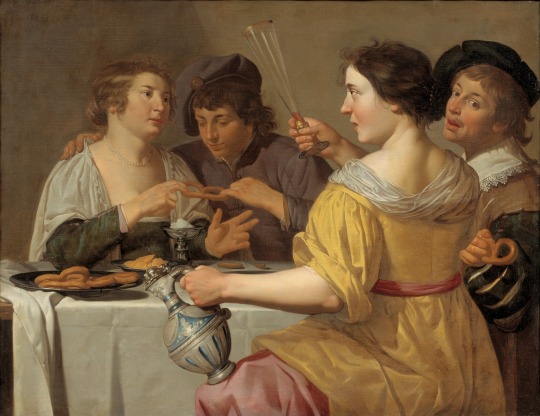
Pulling of the Pretzel Jan Van Bijlert
#1600s#17th century#art#painting#art history#fashion#portrait#scene#genre art#fun#party#dutch art#Dutch Golden Age#Jan Van Bijlert#caravaggesque
139 notes
·
View notes
Text

#Le Festin des Dieux#paris 2024#The Feast of the Gods#Jan van Bijlert#opening ceremony#bacchus#Thetis#Peleus
5 notes
·
View notes
Text

Le Festin Des Dieux (The Feast of God, c. 1635-1640) a painting by Jan van Bijlert.
The Olympics tried to celebrate the Greek myths by presenting a free-range organic tableau, a "living photo" of this painting, The Feast of the Gods, of a wedding with Bacchus, unable to stand since he's so hammered, and a wannabe Minotaur dancer, or some stand-in substitute satyr.
Sadly, everyone is NOT familiar with Greek myths. They think Zeus wrote Cat in the Hat. The Olympics tried to help make everyone familiar with Greek myths by presenting some free-range organic performance art, making tribute to the Feast of the Gods. But it rankled the Christianists because it looked like The Last Supper -- and they assumed Jesus was being mocked somehow.
This only looks like The Last Supper if Jesus had gone out to dinner with some juvenile delinquents and theater kids.
3 notes
·
View notes
Text


Jan van Bijlert - Le Festin des dieux
#philippe katerine#dionysos#ceremonie d'ouverture#paris 2024#percy jackon and the olympians#jeux olympiques#Jan van Bijlert#le festin des dieux#feast of the gods
4 notes
·
View notes
Text
Jan van Bijlert, “Shepherd Holding a Flute”, c. 1630-35

2 notes
·
View notes
Text
Sacré bleu! Conservative critics were angered by ‘Last Supper parody’, but art historians say the performance looks instead to a 17th-century Dutch work, "The Feast of the Gods" by the artist Jan van Bijlert (1635-40).
Maybe its time for conservative critics to lie back and think of Dionysus instead 🤪
#The Guarian#art history#art education#The Feast Of TheGods#Jan Van Bijlert#The Last Super#Leonardo Da Vinci#Olympcis#art critics#art historians#lgbtqia
0 notes
Text















"i drink to make other people more interesting."
#artist is gerrit van honthorst#artist is peter cornelis#artist is eduard charlemont#artist is david teniers#artist is gerard van honthorst#artist is philippe mercier#artist is wilhelm marstrand#artist is jan van bijlert#artist is gabriel ferrier#artist is wilhelm amber#artist is philippe mercier-#artist is eduard theodor ritter von grutzner#artist is john arthur#artist is johann baptist reiter#artist is hermann armin kern#art history#artedit#arthistoryedit
66 notes
·
View notes
Text
No, but lets talk about this. I dug out my grad school notes and everything.
So my grandmother is acting a fool on FB (what else is new).

And I can't respond to her because I might actually give her a heart attack if I shared some of the images included below. But I wanted to rant to someone so here we are. First, yes, the drag bit at the Olympics was inspired by The Feast of the Gods, by Dutch artist Jan van Bijlert in the 1630's, not The Last Supper mural by Italian artist Leonardo da Vinci, in the 1490's. And yes, pearl-clutching Christians need to touch grass and tone down the victimization because it's getting embarrassing. I think we've established this now from multiple reputable sources.
But like. Even if the Olympics DID make a drag parody of the The Last Supper, it's SO funny that Christians are holding up that painting as some sort of ideal heterosexual conservative icon when plenty of historians (including my Renaissance art prof in grad school) are certain da Vinci was gay. The man had no documented female lovers but was arrested for sodomy with a male prostitute (though charges were later dropped). He had extremely close relationships with his secretary Salaì and pupil/friend Francesco Melzi who both traveled the world and lived with him for most of their lives and through the end of his. When he died, Melzi wrote in a letter that there was "a burning and passionate love" between them. And Salaì modeled for da Vinci all the time--let me tell you, there are some hella erotic drawings of him. Exibit A:

But maybe heterosexuals draw their bros erect all the time and label the drawings "Angel Incarnate." Maybe.
Also if Christians really want to clutch their peals, this drawing might look familiar because da Vinci created his well known John the Baptist painting based on this and other sketches of Salaì.

Well, hello. Also worth noting: there are lots of fun doodles in da Vinci's sketch books, including things like the below--two dicks with legs poking at a butthole labeled Salaì.

Do you REALLY think that this (likely queer) man would care if someone based a drag show off one of his paintings?
#lol#leonardo da vinci#olympics#christianity#to be clear I am a queer christian and i would love for all these people to stop embarrassing me#lgbtq#art history#funny story
900 notes
·
View notes
Text

“The Feast of the Gods”, c.1635-40 by Jan van Bijlert (1597-1671). Dutch painter. Musée Magnin, Dijon, FR. oil on canvas
108 notes
·
View notes
Text


Le Festin des dieux
by Jan van Bijlert (circa 1597/1598–1671)
Renaissance paintings are so offensive !
22 notes
·
View notes
Text

Jan van Bijlert
16 notes
·
View notes
Text

Jan Hermansz van Bijlert (Dutch, 1587-1671), "Jupiter and Semele," 17th c.
Semele, a mortal woman (and daughter of a human King), impregnated by Jupiter (Zeus), is dying after just having given birth to Bacchus (Dionysus), whom the Father God is holding.
In Greek mythology, the infant Dionysus was turned over to Silenus, a Satyr-god, to raise. Perhaps it was all to the good--Zeus would never win a "Father of the Year" competition.
15 notes
·
View notes
Text
The Dionysos gallery (4)
We finally reach the end of this long Dionysos series - and after dissecting the myth of Dionysos, we reach the conclusion of this gallery, kindly offered by the French Museum of Wine (you can find it all here).
First, I will include there the various paintings I did not have enough space to add in previous post, two paintings coupled with an analysis section I will loosely translate.
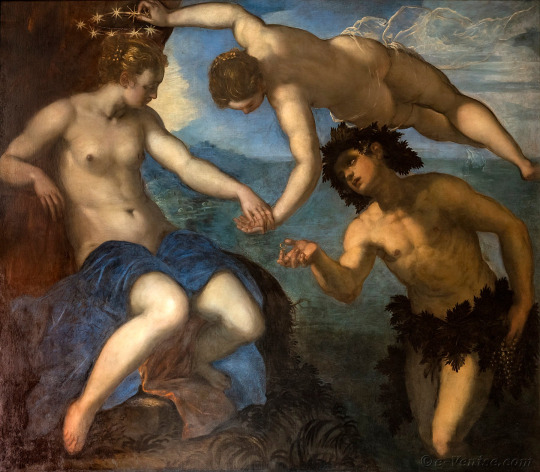
Le Tintoret's Ariadne, Venus and Bacchus
The motif of the encounter between Bacchus and Ariadne (who had been abandonned by Theseus on the island of Naxos) and Bacchus' offer to the woman of her famous gold crown made by Vulcan (according to Ovid's Fasts), has been a strong recurring motif in paintings, explored by numerous artists.
"Liber" or "Liber Pater" was originally a fertility/fecundity god whose worship took place within the oldest era of Ancient Rome. By the 7th century BCE onward Liber was associated with wine, and as a result the Romans ended up assimilating him with Bacchus/Dionysos. "Liber" as such became a mere Latin translation of the terms "Dionysos" or "Bacchus" - "Pater" meanwhile kept its role of expressing respect and adoration towards a god.

Jan van Bijlert's The Feast of the Gods
This 1630 painting currently kept at the Magnin Museum (Dijon) asks a quite troubling question: is this pagan scene... secretly a Christian Last Supper?
We are on Olympus. The gods are gathered for a feast. On the left we see Minerva, Diana, Mars and Venus, with Cupid by their side and Flora behind them. At the center of the table, a crowned Apollo appears holding his lyre. To the right we can recognize Hercules thanks to his mace, and Neptune with his trident. Unfortunately several of the Olympians are missing due to the painting having been cut off: for example there is a peacock, but no side of Juno. The motif of the "feast of the gods" was very popular in Holland, ever since an engraving by Goltzius "The Wedding of Psyche and Love" (see below).
However, van Bijlert's painting can be read very differently. In the Netherlands, due to the appearance and domination of Protestantism, all pictures had been banished from the temples, putting an end to the religious painting. As such, it seems that this painting hides within it a Christian scene of the Last Supper. Apollo at the center has the same halo as the Christ usualy has, and the characters surrounding him are twelve in total like the Apostles. Now, while it is a very interesting theory, we should stay careful. As we said before, it seems the reason some of the gods are missing is because the painting was cut (a practice very common at the time) - again, there's this peacock that implies Juno used to be included. Second element: yes the Christ has a golden halo in painting to symbolize his role as the Lord of the Heavens, but long before that, the idea of a halo of light did belong to Apollo. The Greeks saw him as the "solar god" by excellence, since he was the power that ruled and organized all things, and the one that regulated spirits and intelligences (in fact, he was complementary of Dionysos since Apollo tamed, controlled and shaped the vital force and bursts of life embodied by Dionysos).
Bijlert lived in Rome in the beginning of the 1620s and we know that, just like many of his fellow painters, he was deeply impressed by the art of Caravaggio. However, the Italian painter's fame was dwindling by then - and by the 1630s his art had lost any influence over European paintings. In this decade, Bijlert focused his works on the new international trend, the classicism. Here the composition of the panting and the diurnal luminosity are purely classicist. However, the dancing satyr and the leaning Bacchus on the foreground belong to the "naturalism" of Caravaggio: ocre-colored flesh, close-ups on bodies in non-conventional positions...
(Here is Goltzius' engraving)

Second part of this post, extending from the analysis above: Christianized Dionysos! Because yes, you might be surprised to learn that the motif of Dionysos/Bacchus in classical painting was heavily Christianized or syncretized with Christian figures...
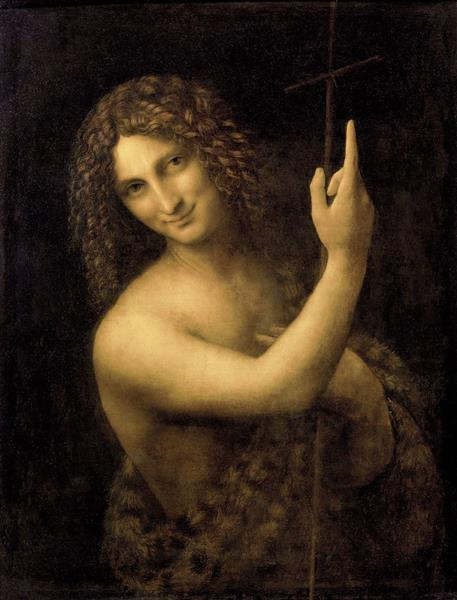
Leonardo da Vinci's Saint John the Baptist
This Saint John the Baptiste has what has been called a "pagan beauty", and this painting with a Tuscany imagery "renews the syncretism of the patron of Florence" - perhaps due to the passion for Antiquity the town had when the painting was created. Indeed, while saint John here holds a cross symbolizing the Passion of the Christ, he is dressed in a panther's skin, reminding of the cloak of Bacchus...

Leonardo da Vinci's atelier: Saint John the Baptist-Bacchus
Once again this painting shows the syncretism between the figure of saint John and the character of Dionysos. The painting was first recorded, in the royal archives, as "Saint John in the desert". However, at the end of the 17th century, perhaps due to a restoration of the painting, the name was changed to "Bacchus in a landscape". Here we have Christian symbols: a finger raised to the sky, a stag resting on the ground... But we also have Bacchic attribute: a thyrsus, grapes, a panther's skin, and a crown of what might be ivy or vine-leaves.

Caravaggio's Saint John the Baptist
Here again we have the attributes of Bacchus: the vine, of which Bacchus was the god, and a ram, an animal traditionally sacrificed for the deity. Historians of painting are agreeing that the reason the Caravaggio associated John the Baptiste with Bacchus was because it allowed him to depict the saint naked, and eroticized, very probably to reflect his own homosexuality.
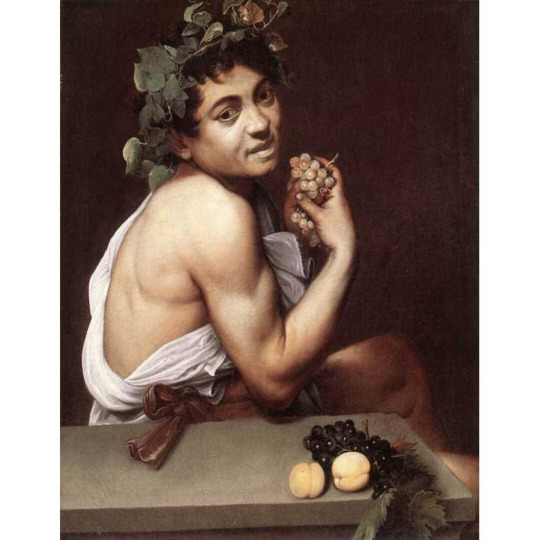
Caravaggio's "Sick young Bacchus/ The ill little Bachus"
This panting of Caravaggio has been interpreted as a self-portrait in a Bacchus-Christ fusion that is very sexual. Here, Caravaggio offers himself to the libertine cardinals of Rome, in an erotic "communion" (remember, "eucharis", means "the good flesh"). The action of carrying to his lips golden grapes gorged with juice is very sensual. Crowned with ivy, dressed in an ancient toga (which reveals a muscular shoulder), he is holding green grapes to his chest, as if he was about to press them. It has been thought that there the Greek wine of Dionysos is a mask or assimilation for the wine of the Christian mass - the invitation is for always a greater feast and bigger celebration, the wine of the Christ "subliming" the wine of Bacchus, ultimately becoming the wine an "universal mass" beyond any religion or era.
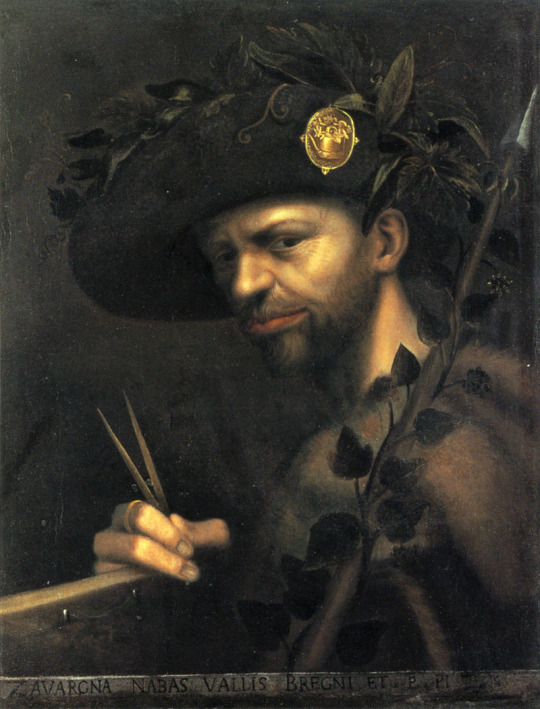
Giovanni Paolo Lomazzo's "Self portrait as a crowned Bacchus"
This painting depicts Giovanni Paolo Lomazzo in his outfit of president (called an "abbot") of the Acacademia della Val di Blenio (Ticino) - Lomazzo had just been named to this function, as the inscription at the bottom of the picture reminds the viewer. The Academy gathered all the best artists of Milan - painters, sculptors, musicians... And it was placed under the protection and patronage of Bacchus, the god that relieves from sorrows and worries, the god that inspires joy, the god that stimulates the mind and the creation, the god that frees from bondage. As such, it explains why this self-portrait has Lomazzo as Bacchus. It was an answer to the many disasters of the era, as well as to the new austerity imposed by the figures of the Counter-Reform - such as Charles Borromée, who was the archbishop of Milan and a cardinal within the Catholic church.
The Bacchic references are numerous here. The hat is wrapped in a garland of laurel and vine, with a medallion depicting vine too. There is a thyrsus surrounded in ivy. And finally there is a goat-skin, reminding of how when he was a child Bacchus was turned into a "kid" (baby goat) to avoid Juno's wrath. The compass however within the man's hand is not a symbol of Bacchus. Held like a paint-brush, it is meant to symbolize how Lomazzo "leads" and "drives" his own career like a captain would pilot his ship.
#the dionysos gallery#the art of the myth#dionysos#dionysus#bacchus#syncretism#saint john#john the baptist#art#painting#folk christianity#christian art
19 notes
·
View notes
Text
Le Festin des dieux 1635-1640, de Jan Harmensz van Bijlert

La cène de Joan de Johannes

Paris 2024

Quoiqu'il en soit c'était le diner de cons à la Macron

8 notes
·
View notes